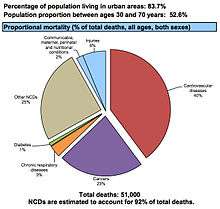Health in Finland
Finland has a history of more effective public health interventions than most countries have been able to achieve.
Risk factors

The total annual alcohol consumption has risen from 7.6 litres (in 1985) to 10.0 litres of 100% alcohol equivalent per capita in 2010. There has been a small reduction in alcohol consumption in the recent years. Alcohol use is highest in the Northern Finland with 10,9 liters and lowest at the Åland Islands with 5,7 liters per person.[1] Although the consumption is average to other western countries, binge drinking with especially teenagers and becoming intoxicated has remained as a characteristic of Finnish drinking habits.[2] Finland has a national alcohol programme to reduce the long-term effects of alcohol. The World Health Organization has published a list of countries by alcohol consumption.
Smoking among adults has shown a marked decline over the past thirty years in most OECD countries. Much of this decline also in Finland can be attributed to policies aimed at reducing tobacco consumption through public awareness campaigns, advertising bans and increased taxation. Smoking in Finland has reduced, and now the smoking rates among adults in Finland in 2009 stood at 18.6%, lower than the OECD average of 22.3%.[3]
Drug use is not a major public health problem in Finland. The most commonly used drug is cannabis. According to a study from 2008, the percentage of the population aged 15 to 69 who had at some point in their lives tried cannabis was 13%; 3% of the population had used cannabis within the previous 12 months.[4]
Overweight and obesity are common in Finland. Half of the adults are overweight, and every fifth adult is obese. The weight in men has increased since 1970’s, in women since 1980’s. Among the Nordic countries Finland ranks the highest in a percentage of adults who are overweight. In comparison to other European countries, Finland is slightly above the average but overweight is still more common in South Europe and Great Britain. Overweight among children and adolescents has also become widespread. The number of overweight 12- to 18-year-olds has nearly tripled in the past four decades. 10% of boys and 15% of girls in preschool were overweight in a follow-up from 2007 to 2009[5]
Communicable diseases
HIV/AIDS is not a major public health concern in Finland. The prevalence among adult population on 2009 was 0.1%.[6] HIV/AIDS in Europe is much more common than in Finland, and the countries very near to Finland have much higher prevalence rates, due to increased travel HIV/AIDS rates in Finland may rise.
Noncommunicable diseases
The most significant public health problems are currently circulatory diseases, cancer, muscoloskeletal diseases and mental health problems. Emerging problems are obesity, chronic lung diseases and type 2 diabetes.[7] 300 000 Finns are diagnosed with diabetes. Approximately 200 000 suffer from type 2 diabetes unknowingly and many more have prediabetes. The number of people with diabetes are estimated to double in 10 years. Most of the incidences could be prevented with healthy life styles, i.e. sufficient level of physical activity, obtaining normal weight and eating healthy.[8]
Major causes of deaths in Finland are cardiovascular diseases, malignant tumors, dementia and alzheimers disease, respiratory diseases, alcohol related diseases and accidental poisoning by alcohol.[9] In 2010 the leading causes of death among men aged 15 to 64 were alcohol related deaths, ischaemic heart disease, accident, suicides, lung cancer and cerbrovascular diseases.[10] Among women the leading causes were breast cancer, alcohol related deaths, accidents, suicides, ischaemic heart disease and lung cancer.[11]

Mental health
Suicide mortality in Finland has generally been one of the highest in Europe, but it has reduced to 18 per 100 000 population in 2005. One reason for this may be the large national suicide prevention project which was carried out between 1986 and 1996.[7] The World Health Organization has compiled a list of countries by suicide rate. There is a high level of education of mental health workers in Finland and several effective mental health programs have been conducted within at-risk groups[12]
See also Healthcare in Finland
References
- ↑ "Alkoholijuomien kulutus 2010" (PDF). Terveyden ja Hyvinvoinnin Laitos (in Finnish). 2011. Retrieved August 3, 2015.
- ↑ "Alcohol use in Finland". National Research and Development Centre for Welfare and Health (Stakes). 2005. Retrieved 2008-04-18.
- ↑ "How Does Finland Compare" (PDF). OECD Health Data 2011. Retrieved 2011-12-13.
- ↑ "Drug Situation in Finland 2010". National Institute for Health and Welfare. Retrieved 2011-12-13.
- ↑ "Lihavuuden yleisyys Suomessa". THL (in Finnish). Retrieved 2014-09-07.
- ↑ "European HIV and AIDS statistics". Retrieved 2011-12-13.
- 1 2 "Finland - Health system review 2008" (PDF). European Observatory on Health Systems and Policies. Retrieved 2011-12-13.
- ↑ "Diabetes". THL (in Finnish). Retrieved 2014-09-07.
- ↑ "Causes of Death 2009". Statistics Finland. Retrieved 2011-12-13.
- ↑ "Leading causes of death among men aged 15 to 64 in 2010". Official Statistics of Finland. Retrieved 2014-09-06.
- ↑ "Leading causes of death among women aged 15 to 64 in 2010". Official Statistics of Finland. Retrieved 2014-09-06.
- ↑ "The OECD: Finland must make mental health services more widely accessible". STM. Retrieved 2014-09-07.